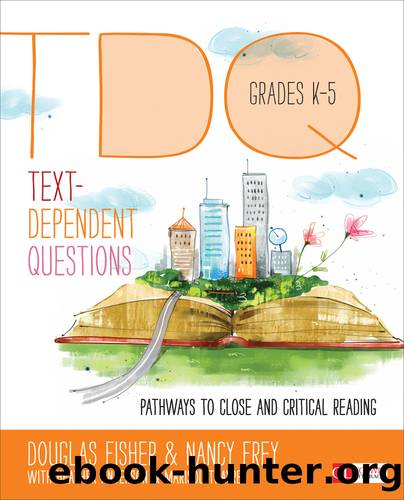Text-Dependent Questions, Grades K-5 by Douglas Fisher & Nancy Frey & Heather Anderson & Marisol Thayre

Author:Douglas Fisher & Nancy Frey & Heather Anderson & Marisol Thayre
Language: eng
Format: epub
Publisher: SAGE Publications
Published: 2015-08-17T15:09:04.711000+00:00
Figure 4.2 Language Chart for No, David!
Speaking and Listening Standards
The standards are replete with opportunities for expanding speaking and listening skills through extended discussion, and standards 1, 4, and 6 have been reviewed in previous chapters. But standards 2 and 3 are of particular note in the context of determining text meaning. (Figure 4.4 lists the grade-specific speaking and listening standards.)
Standard 2 in speaking and listening aligns with reading standard 7âs emphasis on using diverse texts, media, and visual displays. To be clear, analysis of nonprint media is similar to analysis of print media (What does the text say? How does the text work?), but we have chosen to spotlight diverse formats in this chapter precisely because these often offer a path for further contextualizing content.
After a long winter that seemed to never end, spring finally came to the northwestern community where Jayla Lewis and her third grade students live. In preparation for the inevitable arrival of spring, Ms. Lewis video recorded adults at her school reciting the poem âAfter the Winterâ by Claude McKay (www.poetryfoundation.org/poem/237358). On the first warm day, she played a video that included readings of the poem by the childrenâs principal, school secretary, and custodian as well as some of their teachers and a parent. The students read the poem in print and discussed its meaning, especially in visualizing the âsummer isleâ the poet described, and located photographs that illustrated the poem. (We will explore this project in more detail in Chapter 5.)
Standard 3 in speaking and listening offers more direction on the role of logic and reasoning. In the same way that reading standard 8 requires students to locate and analyze reasoning within a text, speaking and listening standard 3 requires effective speakers and listeners to adhere to a logical progression in their discussions. While standard 4 (discussed in previous chapters) reflects the demands on the speaker, standard 3 asks students to use their listening skills to detect when and where these demands occur.
Hannah Johnstoneâs first grade science students are studying the patterns of animal parental behavior that help animal babies survive. They view a National Geographic Kids two-minute video several times. The video shows wood duck babies as they hatch and then take their first plunge into the water. The narrator describes their 15-foot jump from the nest as âthe big ordeal.â He then asks about the courage of baby ducks and states that if the ducks fail to jump, they will starve. Ms. Johnstone and her students list the visual and narrative information that supports the description of the big ordeal, the courageousness of the ducks, and the purpose of the mother duckâs behavior.
Figure 4.3 Language Standards That Focus on What the Text Means
Download
This site does not store any files on its server. We only index and link to content provided by other sites. Please contact the content providers to delete copyright contents if any and email us, we'll remove relevant links or contents immediately.
Figuring Out Fluency in Mathematics Teaching and Learning, Grades K-8 by Jennifer M. Bay-Williams & John J. SanGiovanni(243)
The Principal's Guide to Curriculum Leadership by Sorenson Richard D.;Goldsmith Lloyd M.;Mendez Zulma Y.;Maxwell Karen T.;(171)
Macmillan Primary Grammar 2 Pupil's Book by Unknown(142)
English Grammar Practice--The Noun by Roxana Nastase(139)
Text-Dependent Questions, Grades K-5 by Douglas Fisher & Nancy Frey & Heather Anderson & Marisol Thayre(132)
Learning from Accidents 3rd ed by Trevor Kletz (2001)(128)
Harnessing Technology for Deeper Learning by Scott McLeod(120)
Deep Change Leadership by Reeves Douglas;(116)
English Language Program Administration by Unknown(115)
A Guide to Curriculum Mapping by Hale Janet A.;(110)
The Grammar Teacher's Activity-a-Day by Jack Umstatter(107)
Using Equity Audits to Create Equitable and Excellent Schools by Skrla Linda E.;McKenzie Kathryn B.;Scheurich James Joseph;(100)
Using Data to Close the Achievement Gap by Johnson Ruth S.;(99)
Differentiated Instructional Strategies for the Block Schedule by Gregory Gayle H.;Herndon Lynne E.; & Lynne E. Herndon(98)
The Power of SMART Goals by Conzemius Anne;O'Neill Jan; & Anne Conzemius(97)
Aligning and Balancing the Standards-Based Curriculum by Squires David A.;(96)
How to Do Everything with Google Tools by Unknown(94)
Beyond the RTI Pyramid by Bender William N.;(92)
You've Got to Reach Them to Teach Them by Schreck Mary Kim; & Schreck(90)
